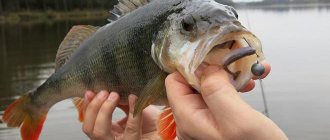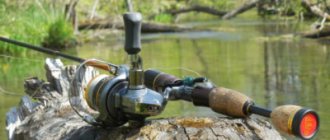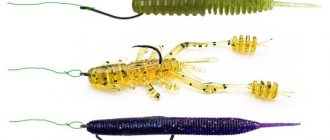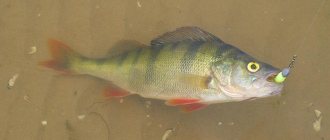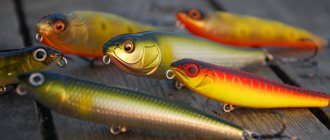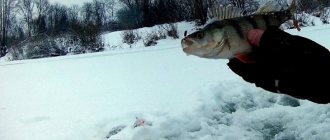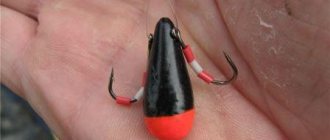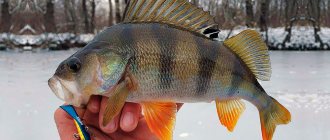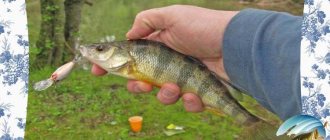Yuri 12/22/2020 89
There are different ways to catch predatory fish. In addition to the well-known ones, there are also those that few know about. Next, we will analyze in detail such gear as a bombard for perch. This fishing tackle is distinguished not only by its catchability, but also by its originality.
Let's talk about installation, features of its operation and nuances that any fisherman needs to know.
First, let's figure out what a fishing bombard is for catching river perch.
What kind of gear is this?
This tackle also has another name - sbirulino. It looks like a transparent float, usually made of plastic, containing water inside.
The bombard is used for spinning fishing, most often for long casting. This tackle is often used together with lightweight baits - these are spoons and spinners, microjigs and other baits that predators are not averse to feasting on.
The bombard makes the spinning rod universal. A rod test of more than 10 g does not allow you to perform accurate casts over long distances. A load of this type allows you to start mounting gram gear and catch predatory fish far from the shore.
Perch. Bombarda and microjig
Near the shore there is a dense carpet of grass, behind it there is a drop-off along which schools of perch cruise. Casting from the shore is futile: a couple of turns of the reel, and the bait gets stuck in the grass. What to do? The answer is simple: cross to the other side. And this is just one of a number of possible situations when a bombard may be useful to us when catching perch with a microjig.
Secret weapon
I confess, once we saw two spinning rods approaching our cherished place in the distance, we began to hastily dismantle the gear with sbirulino rigs and uncover the spinning rods for wobblers. It’s a shame to reveal such secrets to the first people we meet, because no one revealed them to us; we figured it all out ourselves, spending a lot of time on it. Yes, and there are different spinning anglers, I’ve seen it myself more than once: they stretch the net from shore to shore, while they themselves fish on the sidelines with a spinning rod. However, they are not spinning players at all, but so... But enough about the sad things. It’s better to tell you how our company of eternal experimenters came up with this idea. Situation one. On a very small pond, a friend took a bombard tackle only because on the last fishing trip he could not throw the bait to the perch fattening on the wide dam. On the same reservoir, such a design seemed out of place, besides, the wind was blowing at the back and the microbait flew a decent distance without any additional strays. This fact contributed to a fair number of jokes we made about the “bomb thrower.” However, what happened next literally disheartened us. Imagine the picture: three fishermen stand shoulder to shoulder, throwing baits perpendicular to the shore, but two of them have small perch in their catches, and even then very rarely, and the third has real humpback whales and almost every cast! And all this happens not in Astrakhan, but in the Moscow region, where catching at least one decent perch during fishing causes indescribable delight, followed by a description of the intricacies of fishing to everyone who gets in the way. Given the context, it is clear that the third angler was fishing with a bombard. We argued for a long time about the reasons for our friend's success. At first they agreed that a couple of extra meters of casting was not enough for us, the losers, but the “scorer” claimed that there were bites almost near the shore. In the end, they decided that the perch swam for the bait from afar, and decided to attack after some time, closer to the shore. In general, we didn’t really understand anything - a mystery of nature.
Situation two. Not everyone learns from mistakes - that's a fact. The microjig epic with ultralight would have continued for a long time if not for another success of a friend. This is what happened. He arrived at the same place, again with a bombard, and the perch was biting again, albeit not as big as last time, but steadily. The bites were almost right at the shore, and my friend decided to switch to ultralight, saying that there was no point in using a bombard, since the fish were literally under his feet. I collected my gear and left - no perch. I thought that the flock had left, but - praise be to the experimenters! — just in case, I decided to make a few casts with a bombard. It turned out that the striped one never left...
Wiring
So what's the deal? But the fact is that the speed at which the bait falls, thanks to the short leash and the slowly sinking bombard, is much less than when fishing with a classic ultralight. A small compact jig head with bait easily penetrates the water column and rushes to the bottom, but in a rig with a bombard, the falling speed is reduced significantly, and the bait cannot fall below the bombard by more than the length of the leash. Here you also need to take into account that with more or less fast reeling, even a sinking bombard rushes into the upper layers of the water, and when the reeling speed decreases, it begins to sink, i.e., with a certain skill, you can “lick” almost any underwater mound with bait.
Once, on one, well, very popular fishing forum, out of naivety, or maybe stupidity, I decided to share my experiences. First they sent me to the topic about the float, then they advised me to buy a spinning rod for $2000 in order to throw small baits into the endless blue distances. Let me answer briefly: spinning is fishing by spinning, and a bombard is a load, not a bite alarm; with a spinning rod, even for $20,000 you won’t jump above... the laws of physics. Although, what’s the point of explaining anything to such advisers - they already know everything, don’t read magazines and don’t listen to their colleagues. However, I am not calling for abandoning the ultralight, but I want to focus on the fact that in certain conditions, fishing with a bombard can be more effective than fishing with an ultralight, and that the point here is not only in the casting distance, although this is often the key factor. With good tackle, a micro jig can really be cast far, but how can you make the bait float in the water? You can put a glider, but when casting, the windage will increase, and you will have to forget about the range, and you still need to select a suitable glider, and for almost every bait, and this is a waste of time and nerves. So it’s better not to reinvent the wheel, but to use what has long been used by practical fishermen in many European countries. Bombard
The choice of bombard largely depends on the distance to promising points and, of course, on the test and construction of the rod. On most reservoirs near Moscow (ponds, dams on small rivers) to catch perch with microjig baits, I use bombards weighing from 8 to 15 g, mostly slowly sinking, made of plexiglass. When choosing a bombard in a store, the first thing you should pay attention to is the antenna - it must be firmly glued in and not chipped. For catching perch on ponds, bombards without any additional weights in the rear are better suited. The manufacturers' idea is clear - thanks to the shifted center of gravity, the bombard should fly further. It flies, but when reeling in, it stands up vertically and constantly strives to float to the very surface, which makes it difficult to navigate to a given horizon.
Rod
Nowadays, fast-action rods are very popular among spinning fishermen, but they are not the best option for catching perch with a bombard. The fish will often disappear, the casting range will be significantly reduced, and the pleasure of fishing will become less intense. Fast fishing poles with a bombard will come in handy in the current. In conditions where a tensile monk is used as the main fishing line, and even blows out a loop, it is simply not possible to make a high-quality hook with a “snotty” stick. For a pond, it’s better to take a semi-parabolic rod with a length of 2.7 to 3 m. The good news is that inexpensive and high-quality slow rods can be found in almost any fishing store, and you don’t need to chase the brand - we’re not catching salmon on the rapids.
Main line
Since fishing is carried out in still water, it is better to wind the reel with braid. Bites will be more noticeable, and a slow rod will compensate for the inextensibility of the cord, but the hooking should not be made too sweeping. As for the diameter of the braid, you don’t have to take the choice too seriously. The rod is long and flexible, the float is a weight of decent weight, and therefore the equipment will fly far even with thick fishing line (within reasonable limits, of course). By the way, this is a good way to save on braid - use the one that is already wound on a reel for other purposes, or purchase something specifically for this fishing that is not very expensive, but to be sure, has a slightly larger diameter than that of a trusted brand.
Leash
But you shouldn’t skimp on the leash, unless, of course, you install an additional leash against pike teeth. In this case, the perch sees exactly it, and there is no longer a need for a thin and high-quality main leash. So should I use a pike leash? Practice shows that the perch bite with it becomes much worse, and therefore it is better to abandon it. True, I have a secret pond where there is no end to small squirrels, and sometimes something decent will be tempted by a microjig on a bombard. There’s no getting around it - I use a short leash made of field cable (it’s not as shiny as a string, and not as thick). But this is rather an exception; the Moscow region has not become so rich in pike to play it safe at the expense of perch fishing.
So, we thread the main fishing line into the bombard, tie a swivel (I use a triple swivel), and to it a leash made of monofilament or fluorocarbon. I like the latter better, as it deforms less when pulled through the grass. The length of the leash is from 1.2 to 1.5 m, the diameter is from 0.15 to 0.18 mm. For two seasons now I have been using Colmic Wind fluorocarbon for various lead rigs, and I also use it to make shock leaders when fishing with ultralight. I have no complaints about this line, so I am not experimenting in this area anymore. But these are personal preferences - nothing more, there are a lot of high-quality fishing lines on the market now, and it won’t be difficult to find something suitable.
Lures
The most popular baits for such fishing are vibrotails and twisters up to 2 inches in size, and the most popular jig heads are 2 and 4 g. It is better to choose jig heads with short hooks with a wide hook. Perch, as a rule, swallows the bait very deeply, and a short, wide hook allows you to easily remove it from its mouth. In addition, the game of silicone bait is much more attractive when the hook is in the head part, and does not stick out at the very tail. Fishing with a bombard does not involve any unique methods of animation, and therefore the main task of a microjig bait is stable play with super-slow retrieve and on pause, which, I repeat, is much easier to achieve with a compact jig head.
As for specific models, at one time the clear favorite was the 2‑inch Awaruna vibrating tail from Pontoon21. We experimented mainly with it - changing colors, head weight, wiring speed. Then the vibrating tails from Blue Fox, purchased more than 10 years ago, and the Ghost Shad from Herakles, which recently appeared on the market, were used. Among the twisters, JIB Tail from Lucky John and various small things from Action Plastics work well. On one of the ponds, the perch consistently showed interest in the crustacean Hogy Hog (also from Lucky John) measuring 1.6 inches. By the way, on the same pond the striped mercilessly attacked streamers imitating large insects, so, apparently, when fishing with a bombard It’s not always worth limiting yourself to only twisters and vibrating tails, but it’s too early to talk about this seriously - the developments are still very meager.
I suspect that I have completely complicated the reader’s choice of bait. I'll try to improve and give useful advice. You shouldn’t carry a whole bag of baits with you and waste time constantly replacing them; it’s much more useful to spend it exploring the reservoir. Take with you 3 bags of rubber: 2‑inch Awaruna vibrating tails in acidic and natural colors and a pack of 1.5‑inch JIB Tail twisters in fry colors (silver belly and blue or purple back). Don't forget jig heads weighing 2 and 4 g and quality fasteners No. 0 or even No. 00. This pocket set is quite enough for an initial acquaintance with this method of fishing.
Tactics
It is very good if the width of the reservoir allows you to throw the equipment under the opposite bank. After splashdown, we turn the reel handle at an average speed, fishing in shallow coastal waters and at the same time not allowing the bait to scrape along the bottom to avoid getting caught, and in the area of the expected drop we sharply slow down. The bait will begin to slowly descend along the drop. Usually the bite occurs on the dump, but sometimes the perch wanders throughout the entire reservoir, so it can be caught anywhere: in the middle of the pond, near the shore, in the water column and almost at the surface. And it makes no difference whether it’s summer or late autumn. The pond is a small body of water, there are no large-scale seasonal migrations to speak of here, so if there are no bites at the dump, we fish in a variety of places. Wiring with pauses, acceleration and deceleration, sometimes without pauses, quickly or, conversely, very slowly, happens in different ways. If wiring across the pond and with a fan does not give results, you can move the bait along the shore grass, fortunately the length of the rod allows it. It is also useful to fish areas with a bottom overgrown with vegetation - equipment with a bombard will allow you to do this without problems.
Conclusion
At the very beginning, I told how my friend and I camouflaged our gear when we saw spinners approaching us, and then I suddenly decided to reveal our “secret weapon” in detail - why? Yes, because I still believe that sooner or later culture will defeat the barbarian living in man and we will finally begin to take care of nature, using its gifts as needed, and not stocking freezers for future use. After all, these reserves are mute evidence of self-doubt in fishing, because those who know how to fish will almost always catch. And the more people learn to fish with amateur gear, receiving aesthetic pleasure from it, the less we will meet on reservoirs of poachers and underwater hunters without a conscience, ready to shoot fish almost in a puddle, knocking out the broodstock of small reservoirs. Good luck on your fishing!
The article was published in the October 2015 issue of the magazine “Fishing in Rus'”
Varieties of bombard
A bombard for perch fishing is used in conjunction with small baits, which differ in the degree of buoyancy.
When using bombards, it will also be better if the floats correspond to the current gear.
Types of bombards:
- drowning;
- floating;
- slowly sinking.
Types of bombards
The floating type is not buried during use, but is located on the surface of the water. Slow-sinking ones are characterized by a gradual immersion under water, they allow the use of small spinners of medium depth, and sinking ones are advisable to use for fishing at depth.
The method of loading a particular gear influences whether there will be a need to increase or decrease the weight of the bombard.
There are 2 such methods:
- A simple universal method for independent use directly on the shore: drain or replenish the float with water, thereby adjusting its weight.
- The load is built into the tackle itself. You won’t be able to regulate it yourself, but if you have an idea of your baits, you can immediately purchase a suitable option.
- Note! The plastic used to make a bombard has different densities, so the same weight can turn out to be floating, sinking, or slowly sinking.
Bombarda rod
On one of the fishing resources on the Internet, a dispute once broke out about what type of fishing the bombard should be classified as: a spinning rod, a fly fishing rod, or a float rod? In my opinion, this is definitely not a fishing rod, because the latter still does not involve the use of artificial baits, and certainly not fly fishing, because in fly fishing, specialized rods and reels are necessary, not to mention cords and leader lines, plus you can add virtuoso casting skills.
My opinion can be disputed, but fishing with a bombard is closest to spinning fishing, in which, as you know, a sinker is often used to deliver one or another artificial bait to the desired distance. Well, even if the sinker in our fishing is quite peculiar, but, in essence, this does not change anything. And since the bombard is closest to the spinning rod, then a regular spinning rod is suitable for fishing with this equipment. On small and medium-sized rivers, the best spinning rods will be 2.7–3 m long, of course with a test corresponding to the weights of the bombards being thrown. However, it is worth noting that the bombarda loads the blank only during casting, and during the retrieving process, thanks to its streamlined shapes, it creates virtually no resistance, so if the weight of the bombarda is close to the values of the upper test of the rod, then there is nothing to worry about.
There was a case when I made a mistake with the estimated width of the river in an unfamiliar place, and I had to throw a twenty-gram bombard with a spinning rod with a test of 3-15 grams. Of course, it’s better not to do this and have balanced tackle, but it’s worth noting that the spinning rod is still safe and sound. For fishing in large areas, you will need a longer rod. It is advisable, but not at all necessary, to purchase specialized tackle: you can get by with a fly rod or even a feeder rod with a length of at least 3.3 m, although this also has its own nuances: if the banks of the reservoir are heavily overgrown, then it will be difficult to cast with a long rod, since its implementation requires a sufficient amount of free space. It is also worth considering that fly fishing rods, despite their sufficient length, usually have rather modest tests, and therefore when choosing, you should pay special attention to this indicator.
Bombard rig for perch
Simple and short installation of a bombard on a perch does not require special skills. It is necessary to thread it through the main fishing line, and below the bombard a cambric or bead is placed, which plays the role of guarding the knot next below. During the casting process, the float will hit the assembly, reducing its performance, and the rubber cambric will soften this blow. The main line is then tied to a string of interconnected swivels. This allows the gear to avoid twisting and not overlapping during fishing.
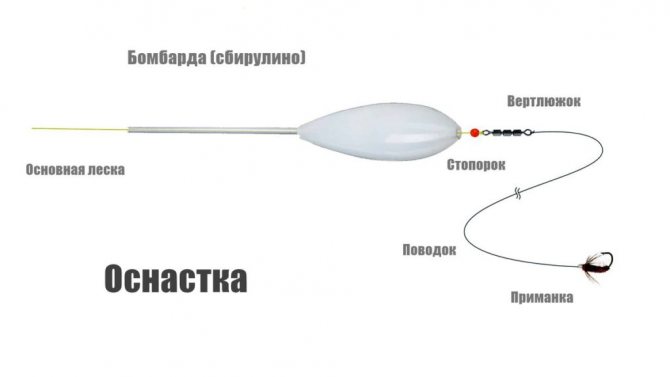
The leash is mounted to the last swivel. It is better if there is a carabiner at the other end, with which you can easily replace the bait (for example, a wobbler or a spinner). The main advantage of such gear is that if there is no bite, then you can always easily put on another bait.
Leash outlet device
In other words, a retractable leash is a sinker fixed at the end of the fishing line and a leash attached a few centimeters above the sinker. A hook with bait is attached to the leash; the bait can play freely, since the close location of the jig head does not interfere with it.
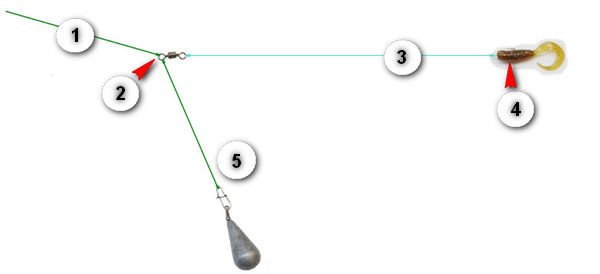
Outlet leash device: 1. Main line. 2. Swivel. 3. Drag 1-1.5 m long. 4. Hook with bait. 5. Weight leash with sinker.
When choosing a sinker, factors such as fishing depth, distance from the shore, current strength, and features of the bottom of the reservoir are taken into account. The weight of the sinker depends on the strength of the current and the depth of the reservoir, and its shape depends on the characteristics of the bottom.
Every experienced angler prepares several leashes with different weights and baits, with different lengths and sections of fishing line. A swivel with a carabiner is attached to the end of the leash. A triple swivel is installed on the main line, to which the bait and sinker are attached. If a triple swivel is not available, you can replace it with two single ones. A fishing line is threaded into the eye of the first swivel, after which the second one is tied. To ensure that the swivel is well fixed and does not slip, you can use silicone stoppers.
You can use any hooks; those used for fishing with a float rod are also suitable. The bait must be firmly secured to the hook so that it does not slip off. Fishing with a retractable leash is carried out in such a way that the bait is drawn along the bottom. The pellets are attached to the hook and perform the loading function.
Why does fishing for perch with a bombard increase the number of bites?
The behavior of bombard gear for perch is always predictable. If the bombard is a sinking type, then when the speed increases, it will still begin to float, and as the speed decreases, it will sink. Using this, you can make effective retrieves by moving the bait “closely”.
Another important advantage is the casting range. The same casting range as from a simple and cheap bombard cannot be achieved even from the most expensive spinning rod.
And experienced fishermen know that perch spends a lot of time far from the shore. Therefore, a good long cast when hunting for perch is already half of a successful catch.
Sometimes anglers try to slow down the movement of the bait by using a glider. But usually this does not give the expected result, but only leads to experiments in setting up the save. And in this case there is no need to talk about casting range.
Consequently, catching perch with a bombard is much more effective than using a pure microjig for this purpose.
If you still haven’t found the answer to the question: “How to catch perch with a bombard?”, then come to the Sazanya Bay Fishing Base! It is here that experienced huntsmen will not only clearly explain, but also teach competent fishing techniques to anyone! Not only beginner fishing enthusiasts, but also experienced fishermen will be able to improve their skills.
In “Sazanya Bay” you will find real trophy fishing for true men! And after a successful fishing trip, you can have a great rest, taste dishes prepared from the fish you caught, and enjoy the amazing beauty of Astrakhan nature!
TAGS:
Flies for fishing with bombard
This is perhaps the most difficult thing about fishing with a bombard. There is very little information about the most catchy flies for bombard fishing, even on the Internet, and often only “field conditions” contribute to correct conclusions. I once tied several flies in the “parachute” style and, before I had even been on the river, I found information on the Internet that this type of flies is used exclusively for fly fishing, by lubricating the brush with flotant and letting the fly “free float.” It is clear that, finding myself on a river riffle, abundantly dotted with aquatic vegetation, I began fishing with a “parachute”, so that in the event of a dull hook and loss of the fly there would be nothing to regret, but the chub was caught and, moreover, very well.
Since then, flies of this type have taken a strong place in the working box. Palmers (imitation caterpillars), amphipods, and various variants of caddisflies also performed well. Special mention should be made of foam flies: imitations of beetles and ants made of this material floating on the surface are rarely ignored by fish. When choosing a fly, it is important to take into account the depth at the fishing spot, because there is no point in placing a “wet” fly on open shallow water - it will not bring anything except hooks. As in any other type of fishing, it is important to believe in success and catch the first fish, and then everything will come on its own. I was lucky: a knitter I knew taught me the basics of this fascinating activity, and then I went on my own, using the “legends” of various flies. For those who do not have the time or desire to make flies themselves, there are plenty of offers on the market. Such well-known flies as Stimulator, Red Tag, Adams and many others are available for free sale. The only advice: choose flies on large hooks Nos. 6–10, otherwise you are guaranteed to eat bleak and other little things!
Vladislav Salnikov
Tags
Carp Buffalo Spring Vobla Asp Winter Crucian Rudd Summer Fishing baits Lower Volga Perch Autumn Fisherman's reminder Lures Bite forecast Fishing in Astrakhan Fishing baits Fishing tackle Fishing secrets Catfish Fishing methods Pike perch Catch Pike
